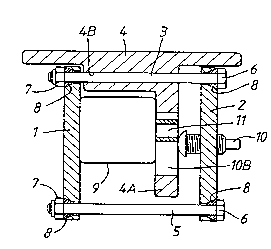Some of the information on this Web page has been provided by external sources. The Government of Canada is not responsible for the accuracy, reliability or currency of the information supplied by external sources. Users wishing to rely upon this information should consult directly with the source of the information. Content provided by external sources is not subject to official languages, privacy and accessibility requirements.
Any discrepancies in the text and image of the Claims and Abstract are due to differing posting times. Text of the Claims and Abstract are posted:
| (12) Patent Application: | (11) CA 2219939 |
|---|---|
| (54) English Title: | STEERING COLUMN CLAMPING MECHANISM |
| (54) French Title: | MECANISME DE VERROUILLAGE POUR COLONNE DE DIRECTION |
| Status: | Deemed Abandoned and Beyond the Period of Reinstatement - Pending Response to Notice of Disregarded Communication |
| (51) International Patent Classification (IPC): |
|
|---|---|
| (72) Inventors : |
|
| (73) Owners : |
|
| (71) Applicants : |
|
| (74) Agent: | SWABEY OGILVY RENAULT |
| (74) Associate agent: | |
| (45) Issued: | |
| (86) PCT Filing Date: | 1996-05-15 |
| (87) Open to Public Inspection: | 1996-11-21 |
| Availability of licence: | N/A |
| Dedicated to the Public: | N/A |
| (25) Language of filing: | English |
| Patent Cooperation Treaty (PCT): | Yes |
|---|---|
| (86) PCT Filing Number: | PCT/GB1996/001163 |
| (87) International Publication Number: | WO 1996036520 |
| (85) National Entry: | 1997-10-30 |
| (30) Application Priority Data: | ||||||
|---|---|---|---|---|---|---|
|
A steering column clamping mechanism has bolt links (3, 5) interconnecting
substantially parallel spaced-apart plates (1, 2) which basically form a
rectangle and are so linked one to another that the rectangle can lozenge to a
parallelogram. One of the connecting bolts (3) is mounted in a bracket (4)
fixed to a chassis of a vehicle, the bracket (4) having a depending reaction
plate (4A) against which an actuating member (10) can be urged to push the
plate member (2) away from the reaction member (4A). Through the linkage, this
causes the other plate member (1) to compress onto a steering column tube
member (9) to clamp it between that plate (1) and the opposite side of the
reaction plate (4A).
Un mécanisme de verrouillage pour colonne de direction comprend des liaisons à boulons (3, 5) reliant des plaques sensiblement parallèles (1, 2) et disposées à une certaine distance l'une de l'autre. Les plaques sont sensiblement rectangulaires et sont liées ensemble de sorte que le rectangle puisse se déformer en losange et prendre la forme d'un parallélogramme. Un des boulons de liaison (3) est monté dans un support (4) fixé au châssis d'un véhicule, ce support (4) comprenant une plaque de réaction descendante (4A) contre laquelle un élément d'actionnement (10) peut être poussé pour éloigner la plaque (2) de l'élément de réaction (4A). Grâce à ce système de liaison, l'autre plaque (1) est comprimée sur une jupe (9) de la colonne de direction de sorte que cette dernière soit immobilisée entre ladite plaque (1) et le côté opposé de la plaque de réaction (4A).
Note: Claims are shown in the official language in which they were submitted.
Note: Descriptions are shown in the official language in which they were submitted.

2024-08-01:As part of the Next Generation Patents (NGP) transition, the Canadian Patents Database (CPD) now contains a more detailed Event History, which replicates the Event Log of our new back-office solution.
Please note that "Inactive:" events refers to events no longer in use in our new back-office solution.
For a clearer understanding of the status of the application/patent presented on this page, the site Disclaimer , as well as the definitions for Patent , Event History , Maintenance Fee and Payment History should be consulted.
| Description | Date |
|---|---|
| Inactive: IPC from MCD | 2006-03-12 |
| Inactive: Dead - No reply to Office letter | 2000-02-02 |
| Application Not Reinstated by Deadline | 2000-02-02 |
| Deemed Abandoned - Failure to Respond to Maintenance Fee Notice | 1999-05-17 |
| Inactive: Status info is complete as of Log entry date | 1999-03-24 |
| Inactive: Abandoned - No reply to Office letter | 1999-02-02 |
| Classification Modified | 1998-02-18 |
| Inactive: IPC assigned | 1998-02-18 |
| Inactive: IPC assigned | 1998-02-18 |
| Inactive: First IPC assigned | 1998-02-18 |
| Inactive: Courtesy letter - Evidence | 1998-02-03 |
| Inactive: Notice - National entry - No RFE | 1998-01-28 |
| Application Received - PCT | 1998-01-26 |
| Application Published (Open to Public Inspection) | 1996-11-21 |
| Abandonment Date | Reason | Reinstatement Date |
|---|---|---|
| 1999-05-17 |
The last payment was received on 1997-10-30
Note : If the full payment has not been received on or before the date indicated, a further fee may be required which may be one of the following
Please refer to the CIPO Patent Fees web page to see all current fee amounts.
| Fee Type | Anniversary Year | Due Date | Paid Date |
|---|---|---|---|
| Basic national fee - standard | 1997-10-30 | ||
| MF (application, 2nd anniv.) - standard | 02 | 1998-05-15 | 1997-10-30 |
Note: Records showing the ownership history in alphabetical order.
| Current Owners on Record |
|---|
| NASTECH EUROPE LIMITED |
| Past Owners on Record |
|---|
| JOHN THOMAS III BOBBITT |
| STEPHEN JOHN BAKER |